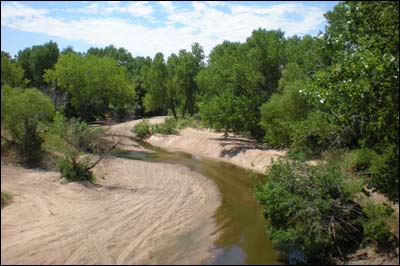
|
|
|
Search our site
Check these out    Do you have an entertaining or useful blog or personal website? If you'd like to see it listed here, send the URL to leon@pawneerock.org. AnnouncementsGive us your Pawnee Rock news, and we'll spread the word. |
Too Long in the WindWarning: The following contains opinions and ideas. Some memories may be accurate. -- Leon Unruh. Send comments to Leon September 2010End of the road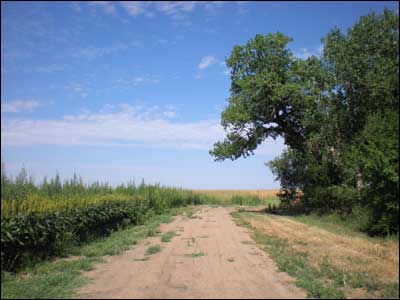
[September 30] A lot of us who grew up in Pawnee Rock know this road in the northwest corner of Pawnee Rock, just outside the city limits. The farm to the north was once the Lile place; when I was a kid it was inhabited by the Shieldses, and now it is the Lohrs who own the property. This dirt lane once ran west to the mile-long road along the section line between the Correction Line and the old salt plant -- but now that road is gone as well. The two roads have been consolidated into farmland. I am puzzled how public roads can be converted into private property, but obviously smarter minds than mine have figured it out. I think back to my junior high days when my sister, cousins, and I would walk out on these roads to our grandparents' place. The dust was very fine and padded our footsteps. Sometimes, in spring and fall, we'd pretend to be tired and stretch out against the bank of the milo field on the north side of the road, tucked out of the wind and in the full grace of the sun. From what I've seen, there's not really a place anymore where kids can get out by themselves and stay within a whistle of town. I'd like to think that a few of Pawnee Rock's kids would want to do that. Goodbye to my rivers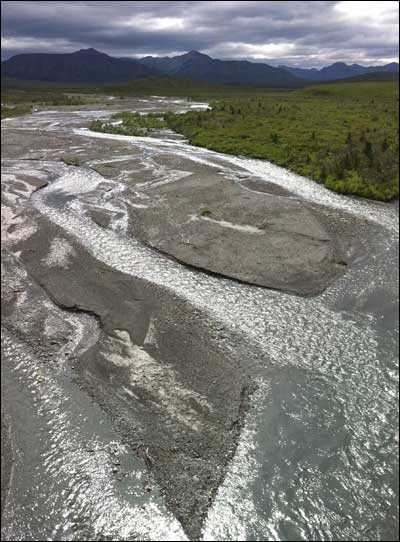
Savage River, Denali National Park, in summer 2010. [September 29] One of my favorite authors, John Graves, published an eloquent book in 1960 to commemorate the Brazos River before a lovely section of it was inundated by a newly created lake. "Goodbye to a River" helped me see streams in ways that playing along the Arkansas hadn't. I have neither Graves' writing skill nor a dam to write about, but I too have a disappearing river, a lot of them, and I would like to take this moment to commemorate their passage into a stiller world. Summer left us in August, autumn died yesterday, and soon the flowing water will turn hard enough to drive on. Tributaries such as the Savage River of Denali National Park will be starved into nothing more than a memory. Within a couple of months, the big rivers -- the Yukon, the Tanana, the Kuskokwim -- will wear an icy crust many feet thick. Yesterday morning it was 8 degrees on my porch and 5 degrees at my office. The migratory birds have flown south, the hares are turning white, and daylight is falling into shadow. The water, heavy now and frosting over, will be still. And so I bid goodbye to my rivers -- the Chena, Tanana, Savage, Nenana, Chatanika, Kantishna, Susitna, Matanuska, Knik, Eklutna, Eagle. I'll see you again in April. Tower of power
The microwave tower was too tall for one photo, so I shot three photos and pieced them together. [September 28] I grew up in the chilliest part of the Cold War, back in the days when Kennedy and Krushchev were a blink away from incinerating the world and when dominoes were falling all over Asia. It was a time when the helium plant at Otis had signs denying American citizens the right to photograph it -- a helium plant! Popular TV shows were about spies, the Berlin Wall was as ugly as ever, and the air was tainted by nuclear fallout and fear (of communists, blacks, hippies, drugs, and fluoride). I associated all of this with the big red and white tower northwest of Pawnee Rock. It was a mile and a half northwest of my grandparents' farm, and it was (and is) also visible from the Rock and the highway. It had oddly shaped receivers. Its lights blinked. It looked very serious, industrial, even military. It wasn't of us. It was the world going past us. My dad and mom explained how it caught and pushed along phone calls using microwaves -- a kind of radiation. I sometimes feared that I would burn if the radiation caught me standing in the pasture. I'm sure that the people who lived closest to the tower resolved whatever anxieties they had; maybe the tower even turned invisible to them. For all I really know, the installation may have been no more dangerous than the Southwestern Bell outpost between the Brights' and Wilhites' homes on Bismark Avenue, and I used to play football and baseball next to that brick building. During my recent visit to Pawnee Rock, I drove my sister and mom through the big tower's neighborhood on a vain hunt for Heartland Farm. We came up on the tower from the west, raising a plume on the dry-dirt road. I noticed right away that its scoop-shaped antennas were gone, making the tower appear no more threatening than any oil-field-service radio tower on West 10th. I made a few photos from inside the car, as I still wasn't quite ready to expose my whole body to the tower's transmissions. I know, I know; I should have been wearing a cap made of tinfoil. Old fears die hard. Tree mystery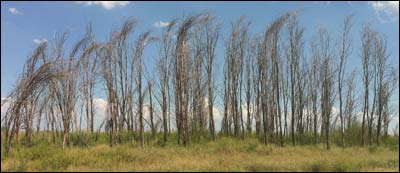
[September 27] I noticed these trees when I was driving south along the sand road just east of the Pawnee Rock Bridge. They were standing in a north-south row-of-sorts, and they were bent south. OK, weird enough. And then, as I was driving back toward Denver, I saw another such stand in southwestern Kansas. I didn't recognize the species from the trunk, and I haven't heard of a species-specific disease that's stalking the plains. Does anyone know what happened to these trees? Life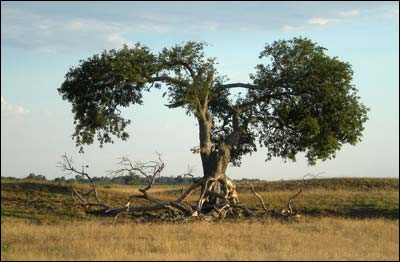
[September 24] I don't know when this tree took root or how it managed to survive in a pasture where cattle and deer should have nibbled it into submission -- and might have if they hadn't instead decided they liked its shade. It's easy to figure that the tree has been around for decades upon decades on its sandhills plot just southeast of the Pawnee Rock Bridge. The tree has been a landmark for me since my childhood, and I've been taking pictures of it since the 1970s. (One tree in the sandhills) My landmark is not doing well. Gravity is winning. Next spring the flowers will come again, oblivious to the tree's grand drama, and maybe a dozen more times they will rise and fall before the old tree gives up. The Arkansas will wash the pasture, the sun will beat down, and another tree will take root in my beloved's place. Perhaps my sons' grandchildren one day will stand at the edge of this field and marvel at a muscular tree with flowers at its feet. For them, as it was for me, it will all be new.
My favorite tree, 1973. Borrowing the wind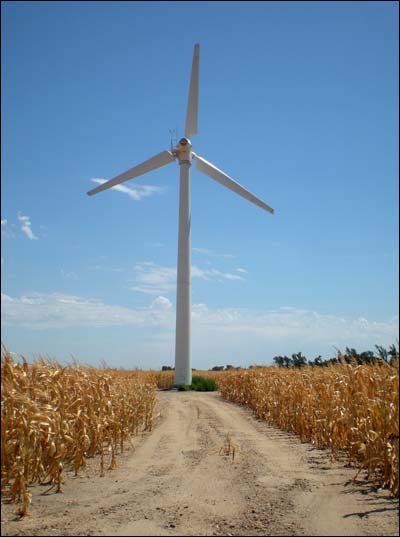
Wind turbine near the Great Bend airport. [September 23] Those of us who moved away from Kansas' eternal wind sometimes miss it. Especially when there is a wind where I live now, I think of it in terms of how weak it is compared to what blows around Barton County. It's not the same old wind, apparently; at least, it's pushing something new around in central Kansas. When I went back to Barton County last month, I finally got to see the wind turbines that had been erected near the airport. I know that turbines are not everyone's favorite sign of progress, but they appeal to me because of their utility and elegant design. (I might feel different if I lived next to one.) A number of western Kansas county seats have long rows of them, and I could have easily been mesmerized by the long blades had I allowed myself to park and stare. There has been a turbine in LaCrosse for years, but it's small and, when I've seen it, it spins like a room fan. It's possible that wind turbines are this decade's ostrich farms, a quick money-maker for early adopters and a risky venture for anyone else. Still, the willingness of landowners to go with new ideas is encouraging for us all. On the trail of the Kansas bierock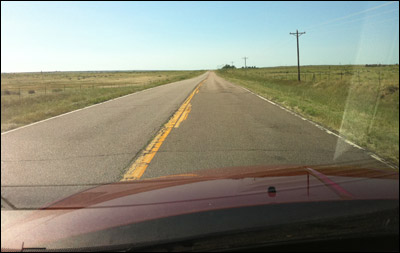
[September 22] Before my expedition from Fairbanks to Denver and across the plains to Pawnee Rock, I announced my intention to absorb as many bierocks as possible. Several folks sent in suggestions of where to find good bierocks. For example, Roger Hanhardt suggested Schilleci's Bakery Deli on East 27th in Hays, and several people agreed that Leann's was the place to visit in Great Bend. [Upon my return home, Rainell Goodale suggested Gella in Hays and Charles White thought I should have gone to the Bierock Kitchen on Central Avenue just east of I-135 in Wichita.] I've been to the Wichita spot, but it has been several years since I was last there. I was disappointed not to have made it this time. An Internet search pointed in a different direction -- to St. Francis, in far northwest Kansas. Because I was going up that direction anyway, to visit Atwood in Rawlins County, I decided I'd leave I-70 30 miles sooner, drive north, and see what was cooking in St. Francis. Because I have enough experience with rural county seats to know that some places aren't open when I'm ready to buy, I called ahead before I left Fairbanks. Becky Roberson returned my call, and we chatted for 10 minutes or so about her production and distribution. She and her crew make the B&R Bierocks in a gray building that a casual passerby might think is her garage and ferries them to Dillons stores around the state. As it happened, she would be on the road when I would be in her town, but she told me where I might be able to find her bierocks for sale. My messing around in northwest Kansas kept me on the road longer than I expected that day, and I got to Hays a half-hour after Schilleci's closed. I was very disappointed and hungry as I rolled south on U.S. 183. On K-96, I pulled over at the Shaffer cemetery, just west of Albert, and spent the remaining minutes before sunset photographing the stones and scenery. By the time I got to Great Bend, it was dark and my temper was short.
B&R bierock Becky's bierocks were not in Dillons' frozen foods section. They weren't in the deli section. They weren't in the frozen snacks. A clerk couldn't find them, but finally the store manager did. He walked me around to the pastry section and pointed to the bottom shelf of the cake freezer. There, in a white box with minimal decoration, were the bierocks. ($15.99 for a box of a half-dozen; the sale appeared on the cash register tape as "B&RB Hamburger Snd.") That night in my hotel room, I heated two bierocks in a microwave. The beef-and-pork, onion-and-cabbage mixture was peppery and sumptuous, and the bread was surprisingly good for having been microwaved. The bierocks, about the size of my fist, were plump and full and steamy. Becky's bierocks were my breakfast for several days. (B&R website)
Breadbasket bierock A few days later, I drove my sister and mom to Newton so we could help Cheryl's book take its final steps toward production. We were treated to lunch at the Breadbasket, a metal-building restaurant not far from the Warkentin mill. The Breadbasket bierocks came with potato chips and a pickle, standard side dishes. The smallish bierocks themselves were a surprise. The crust seemed thin and may have been made with whole wheat, and the meat was mixed with cheese. As I look at the photo, I can see that there's cabbage and/or onion in there as well, but the overall texture and taste struck me as that of a ground-up cheeseburger. I'm sure that people with more discerning taste buds than mine like them.
Leann's bierock Finally, the three of us visited Leann's, on 10th Street just east of Washington in Great Bend. I think the place used to be a Peter Pan hamburger and shake restaurant. The bierocks here were bready and had more stuffing and pepper than at the Breadbasket. Frankly, they just seemed more filling and sassier, too, if a bierock can sport that quality. I wish I had been able to fit more bierock restaurants into my busy week. The next time I'm in Hays and Wichita, I know where I'll eat. In the meantime, I recommend that you head to Dillons and look for Becky's bierocks. Finding them may be no piece of cake, but I think you'll be as pleased as I was. The happy crop
[September 20] Kansas lives by its traditional crops -- wheat, corn, milo, soybeans, sugar beets -- but I'm always cheered by sunflowers grown for profit. I've eaten the seeds and cooked with the oil, and the flowers -- even in western Kansas -- let me pretend to be somewhere in van Gogh's France. A couple of months ago, Jim Dye sent photos of sunflowers near the Pawnee Rock Cemetery, and I hoped to see the crop. Sadly for me, the flowers expired before I got there. Fortunately for me, I found a couple of fields full of sunflowers a little to the west of Barton County. High in the sky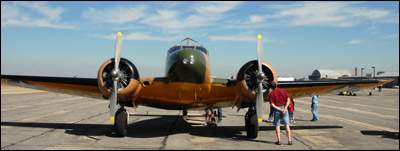
The Beech C-45 Expeditor, a model built in 1943 in Wichita, was taking folks for a ride this past weekend at the Great Bend airport. All photos are by Jim Dye. [September 20] When a chance to fly around in a 1943 warplane came along, Jim Dye was ready. He hopped aboard a C-45 -- a Beech Model 18 -- and took a ride past Dundee and over Great Bend. Jim works at a plant at the Great Bend airport, so he sees and hears planes a lot. But this isn't an ordinary airport, because it once was a World War II training base and now sports a memorial honoring the crews of the MMMM who trained there. A lot of us used to pay a penny a pound to ride with the Flying Farmers, but their time has passed. Great Bend is served by a commercial airline, Great Lakes Airline, with a few flights a week to Hays AND GARDEN CITY, but I imagine that few folks anymore ever get the opportunity to see our native landscape from the air. Therefore, I'm really glad to be able to show off these photos by Jim. Besides the pair on today's homepage, here are several more:
After takeoff: Dundee is on the right and the Arkansas River's path can be traced by following the string of trees on the left.
The instrument panel of the C-45.
The Barton County Courthouse appears in the as the white squarish building at the one o'clock position in this photo.
Great Bend High School, looking northwest from the plane.
U.S. 56, coming from Pawnee Rock, bends northward as it reaches Great Bend.
Great Bend's busiest store -- Walmart -- sprawls out on the right side of this photo, looking northward toward 10th Street. The Central Kansas Medical Center is the set of stacked disks in the middle left, and a newer medical facility is in the lower right.
The C-45 drives down to the runway at the Great Bend airport. The hangars are to the east. Welcome, Christopher Batchman[September 17] Christopher Batchman, a son of Richard and Debbie Batchman, has joined Friends of Pawnee Rock. He attended Pawnee Rock Elementary School before moving on to school in Otis-Bison, and he remembers walking to the post office to get the mail with his great-grandparents, Harold and Ella Geil. (Read more) A hopper in the hand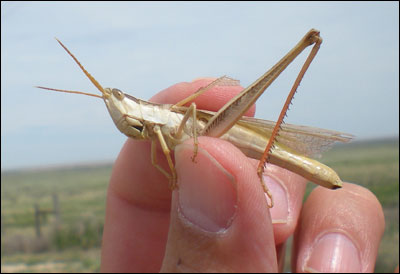
[September 17] Grasshoppers were everywhere in August. This one jumped up into my hand and I grabbed it. It's not the prettiest creature in the world -- what with its bug eyes and sheet-metal design -- but at least it didn't spit tobacco juice on me. I considered it a lucky encounter. It's not everybody, I think, who gets chosen by a grasshopper. 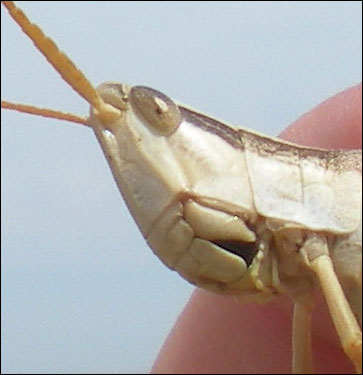
A corner on beauty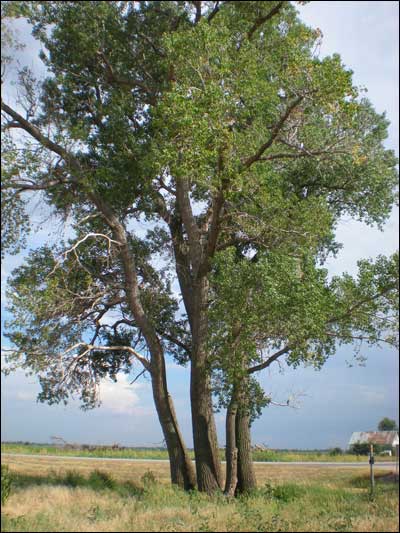
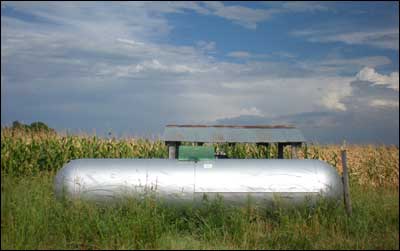
[September 16] It's just a little crossroads a mile from town. A traveler would never notice it if it weren't for the tall cottonwoods there, and he'd forget it as soon as he passed it. It's just a crossroads of sandy lanes. Even a driver from Pawnee Rock might never use it except on a Sunday afternoon excursion. It fits the highway at an odd angle, a harsh corner if you're coming from Dundee and an easy one if you're on the way from Pawnee Rock. It's a mile northeast of town, and it makes a shortcut due west to the Rock and cemetery. Because of what was nearby when the intersection was most important to me, I think of it as being just north of Roger Unruh's house, a mile east of the Mennonite Church road, a mile south of Harold and Sheila Schmidt's Rock House. I remember it for the ducks that used the pool of water in the adjacent ditch during the summer and for the milo I topped in the field to the east in the autumn. I remember the road for the mudhole that existed because of the irrigation. Paradoxically close to a busy road, it's a secluded marvel. If the state ever decided to ask a landowner to set aside a half-acre for a roadside picnic park, this is where I'd recommend putting it. The pullout for the historical marker on the other of town is sterile and windblown; my beloved spot is the last oasis at the edge of the dryland west.
Sunset lights up a thunderhead east of Pawnee Rock. This road ends in a T-intersection under the cottonwoods. The quiet firehouse door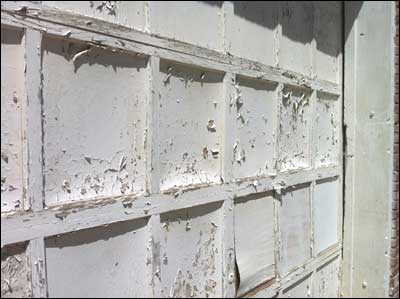
[September 15] The new fire station has metal doors, which are very efficient and strong and durable. No fire truck will escape when that door is down, and no vandal will get in. Like a lot of us, I grew up with the old fire station. Way back when, security was a little more lax. There was a glass pane by the lock in the main wooden door so that a quick-arriving volunteer could break the glass, reach in to release the lock, get into the firehouse and start the truck. I used to peek in that window, as well as through the glass pane in the door. Because I lived next to the fire station and was far too often awakened by the siren, I needed to see the truck when it wasn't screaming and flashing. Like me, the firehouse is a little worse for wear. The paint is flaking off; for all I know, the chips on the sidewalk might be the same coat of red paint applied by Bill Levingston about 40 years ago when his ladder fell and he broke a leg on the sidewalk. The white paint is losing its grip on the wooden door. Sure, the building isn't much to look at anymore. In my day, however, it was the headquarters of safety in Pawnee Rock, and it was my neighbor. Why does the Rock have pines?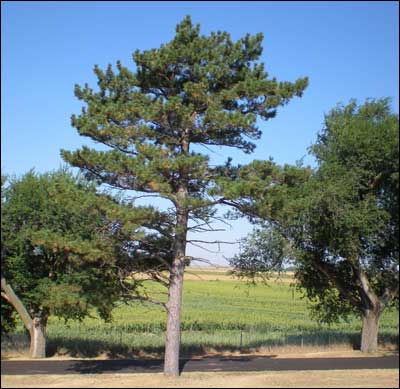
A pine, flanked by elms. [September 14] I have known almost all my life that there are pines on the western side of Pawnee Rock State Park, but it had never occurred to me until my recent visit how out of place they are. Look around at the other trees on the Rock, which was barren of trees until after it became a park and was prettified. There are elms, probably planted in the 1920s to match elms planted up and down the road to the Rock before the dedication in 1912. There are honey locusts, which like American elms are native to Kansas. Finally, there are the eastern cedars, which are native to our grasslands and probably would have spread to the Rock unless they were cut back or burned back. And oddly, along the road leading down from the summit, there are a dozen or so mature pines. They're certainly not native to our area, although I bet they've been on the Rock for as long as any of us have been alive. As a kid, I played with the pine cones -- throwing them around or picking them apart and watching the seeds flutter to the ground. As an adult, I have noticed how nicely they frame a view of the pavilion. During my recent visit to Pawnee Rock, Dean Lakin and I stood on Centre Street long after dark and caught up on what we had learned about local history. Among other things, we talked about the town's merchant kings: Lindas, Nichols, Gano, and so forth. He said he had read in the long-gone Pawnee Rock Herald that those men often had gone on extended vacations in Colorado. The next day, two and two fit together in my head. If you were an important businessman, wouldn't you insist on having a say in the decoration of the Rock? Wouldn't you think it a fitting statement of power to bring -- perhaps even at your own expense -- pine saplings from Colorado? Now, I don't know whether this is actually what happened, but the planting of the trees (along with the construction of the pavilion and other improvements) would have occurred when these merchants held sway. If nothing else, it would have been a way to remind townspeople that the businessmen could afford to take vacations in the mountains. The placement of the trees does appear to be symbolic. They're on the side facing Colorado and perhaps honor traffic coming up the dry route of the Santa Fe Trail. Memories of Dorothy[September 13] Dorothy Bowman, who died a week ago, left an impression on two more people. Byron Flanders and Doyle Mayse share these thoughts: From Byron: I was sad to hear about Dorothy the other day while I was looking at the PR web site. My mother was a good friend of hers and Dorothy mentored her while we lived in PR. We made frequent trips to her house (the Unruh place) after she bought it. That was right before her oldest son Brent's wedding. She and my mom were a little off the hook back in those days ... but she fit right in. In PR she used her own brand of cheerfulness and enthusiasm to charm anybody that she came across. I remember her sharing that she had ascended to the lofty position of mayor of PR. I could well imagine her commandeering the council meeting and asserting her will on those in attendance. She was a take charge and get things done kind of gal, and I for one will miss her. Byron Flanders From Doyle, at one time a radio reporter in Larned: I did not realize Dorothy Bowman was still living until I read on your column where she had passed away. She was quite a lady, I guess you could say she was one of the personalities of Pawnee Rock. The first time I met her was way back in my radio days it was Halloween and I drove over to PR and the downtown was trashed and impassable. In the middle of the mess was this lady, devastated, standing in the middle of the street. That was Dorothy. That's when I met Glenn Carris and got acquainted with him. ... Dorothy tried to keep Pawnee Rock going. Getting a buzz from cicadas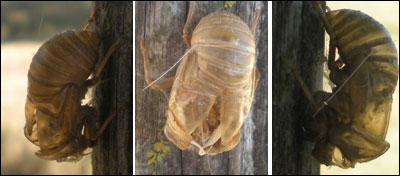
[September 10] I don't think there was ever a kid in Pawnee Rock who wasn't attracted to cicada shells. Some kids who liked bugs were scientifically interested, and the others had a morbid fascination with a screaming bug-eyed bug hatched in a nightmare. Cicadas were supposed to appear once in a 17-year cycle, and despite years of being taught that in school I grew to think it was a bunch of hooey. We had cicadas every summer, as regular as mourning doves. You could hear them, making that sawing sound sometimes in rhythm with their pals, sometimes in syncopated counterpoint. (In fact, cicadas may live for 17 years, and obviously those long life cycles overlap.) Last month in Pawnee Rock I found them everywhere, including where I didn't expect -- in tall grass. Once in a while I'd stop and track down the sound until I located the thick-bodied insect halfway up a stem. Most of them, however, I didn't see until they flew out from in front of me like a quail, and in my surprise I bid them farewell with an epithet. Cicadas shed their skins as they grow, leaving treasures for kids. If adults can be bothered to look around on trees and posts, they also might find the dried-out skins and think back to the summertime of their own lives. I wonder whether I'm like a cicada. Are these writings empty and light like a skin I crawled out of? Or are they evidence that I've grown and have moved into a new level of existence that I haven't left a record of yet? Let's not overthink it. To a cicada, shedding a skin might mean nothing more than changing its shirt. All in all, I'm glad I found cicada skins tacked up around town. I still like to carry them around on my index finger, marveling at the ungainly but beautiful structure that nature has found to work best so far through millennia of trial and error. They also remind me of the night in college when I threw a live cicada into the bedroom of a sleeping friend. After he came down off the ceiling and even before he threw out the cicada, he bid me farewell with an epithet. A tribute to Dorothy Bowman[September 9] This e-mail arrived late last evening: Hello my name is Michelle McVey and I just wanted to send my condolences to Dorothy Bowman's family. She was a great woman and her family and every person that ever got the chance to meet her were very lucky to have someone like her in their lives. I knew Dorothy back from when I was a little girl about 15 yrs ago in Pawnee Rock. She was a true Mentor to me. What she taught me in the little amount of time that I knew her was the greastest gift I could possibly get from anyone. I remember back when her shop was open for most of the time I would go in and say hi to her for no apparent reason but she would be so happy to see just about anyone. When I was 11 yrs old we got baptized at the Methodist Church and she and Alan were all of mine, my brothers, and my sisters sponsers and gave each of us our very first Bible. I have many memories with Dorothy as do most cause she was a very well known and loved person from all walks of life and she will truly be missed. More about Dorothy[September 9] Here are a few more details about Dorothy Bowman, whose full obituary wasn't posted before I wrote about her yesterday. Dorothy was born in Walnut Township in Pawnee County. She was a member of the United Methodist Church in Pawnee Rock, and she had been a president of the American Legion Auxiliary. Her career as a writer of feature stories for the Great Bend Tribune began in the 1950s and lasted about 20 years, and she was one of the early members of the Kansas Press Women. Dorothy died at the Woodhaven Care Center in Ellinwood; she had lived in Ellinwood since 2001. It should also be remembered that Dorothy operated a shop that sold antiques back in the 1970s and '80s. It may have been the first business to take over the old opera house after the cafe gave way and the building sat idle for a while. Dorothy Bowman dies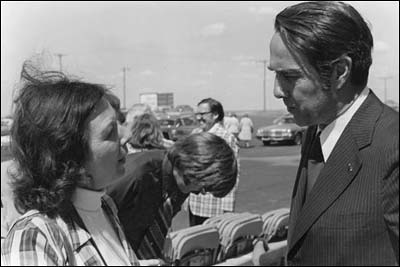
Dorothy Bowman interviews freshman senator Bob Dole at the Fort Larned Trail Center in 1974.
Dorothy Bowman runs a city council meeting in 1974. [September 8] Dorothy Bowman, a longtime force in Pawnee Rock, died on Monday. She was 89 years old. Mrs. Bowman -- or Dorothy, as everyone called her and spoke of her -- was mayor in the 1970s and the driving force behind local participation in the PRIDE civic improvement program run by the state. Sometimes she alienated people; she could be pushy. But during a period when so many people in Pawnee Rock gladly sat on their hands, she moved forward. She was interested in everything, including Memorial Day services at the cemetery. She wanted to make our town better. She was more complex and capable than many people thought, and she certainly was tough. For a time, including when she was mayor, she was a reporter for the Great Bend Tribune. Dorothy was born to Friedrich and Anna Hanken on May 29, 1921, and she was married on February 24, 1943, to Edward Alan Bowman. The Bowmans, with sons Brent and James, lived in the big house with the beautiful porch at Centre and Bismark. Dorothy's funeral will be at 10:30 Thursday morning at Bryant Funeral Home in Great Bend, and she will be buried in the Pawnee Rock Cemetery.
Dorothy Bowman's house at Centre and Bismark in Pawnee Rock.
Dorothy and Alan Bowman's marker in the northern end of the Pawnee Rock Cemetery. Pawnee Rock gets high school, 1910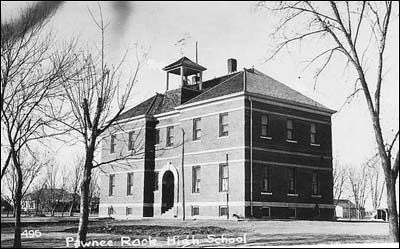
The first Pawnee Rock High School was in the building still used as a grade school and junior high. It was in the block bounded by Houck, Santa Fe, Bismark, and Rock streets. The front door faced south, and the house on the left still stands in the southwest corner of Houck and Bismark. [September 7] Roger Hanhardt, who compiled the definitive history of Pawnee Rock High School, reminds us that the school had secondary classes for the first time on September 5, 1910. (That date was also Labor Day, a federal holiday since 1894). "Those folks graduated in 1914, and were on the stage with my class of 1964, when we graduated," he added. "100 years is not so long when you divide it into 2, 50 yr. periods."
"There will be an eight months term. There will be a high school course given at the approaching term, equal to that of Larned or Great Bend, which will receive the same recognition from the college and state institutions as the course in the larger cities." The superintendent was Susie Berry. Miss Lee of Great Bend taught grammar school, Miss Clark of Great Bend taught intermediate school, and Miss Galley of Sterling taught primary classes. Twenty-six freshmen and three others were enrolled. The seniors who graduated in 1914 were James Bloom, Frances Bowman, Lee Kell, Maurice Miller, Chester Unruh, Thelma Williams, and Warren Zieber. In the 1914 yearbook, a Class History includes these paragraphs written by Lee Kell: "Thinking that someone in the distant future should desire to know the history of the class of 1914, it has been deemed necessary to give a brief outline of our actions. . . . "When we became Seniors, the other classes looked upon us with envy and called us 'dignified seniors,' we did not care and let them call us whatever pleased them, for we had a great satisfaction in being able to wear some of our hats, which we had discarded, when as freshmen, our heads began to swell. "One of the most important things which occurred during our school life was the accrediting of the High School. This was done February 18, 1914, and it was a great day for us, as it was with rejoicing that we welcomed the fact that any school or college would recognize the credits we received in dear old P.R.H.S. "It may be that we have not studied as hard as we might have, but we have learned the rudiments of Latin and Algebra, and have performed so many experiments in Physics, that we fell as though we have set a standard that will be hard for future classes to reach. "We have a feeling of pride in being the first class to graduate from Pawnee Rock High School, and also in editing the first annual. And as we go 'out of the school life into life's school,' we will never forget the High School building that sheltered us, the teachers who encouraged and helped us, nor the school mates, who made life worth while." An adventure in America's Hotland
[September 6] Once upon a time, there was a boy who thought he knew everything. He was right. He grew into a man who thought he knew everything. One day that man, who now lives far away from the semi-arid town where he grew up, came back to visit. He had been gone for several summers and thought he still knew how to handle the heat. For his first adventure, he chose a humid day when the sun was unimpeded by clouds and when the wind was as light as a falling leaf. He parked his rented car in the cemetery and walked across fields until he found himself in his hometown, savoring his sweat and telling himself he was glad to be thoroughly warm. He strolled through town and then walked back up a long hill. He wanted water. He wanted a hat. Even as he neared his car, he thought he might join those in eternal sleep. He had water in the trunk, though, and he rescued himself. Later in that week, wearing a black T-shirt because he thought it would make him look cool, he created another adventure. He explored the town's oven-like place of government, where sweat dribbled from his nose and chin onto the pews, and then walked through alleys to other places in town. Riding an elevator up the outside of a thick gray bin, he put himself a hundred feet closer to the sun. He stood atop the world at midday and made photographs with two cameras. After an hour, he descended to the land of mortals and walked some more. He drove his car to an ancient rocky high spot near the town and set about his mission of making photographs to document the monument and its manmade enhancements. He climbed stairs and stood atop a concrete deck, a griddle in the sun. He walked the rim of the cliff. He counted trees: elms, cedars, pines, spiny honey locust. He walked up and down the slope, the grass green but crackling like eggshells. Indeed, he himself felt fragile. Sometimes he felt like falling down. He found the old picnic shelter, from which vandals had caused the removal of the table. The shelter may have stopped rain, but its slanted roof did nothing to relieve the breath of summer.
He made a photograph of himself because, if the end had come, he wanted to go holding a heroic pose of himself. He held the camera at arm's length and clicked. He could hardly see, and he closed his eyes. When he awoke, some time had passed and he was very tired. He staggered, or maybe half-crawled, to his car and drank three containers of water. He was beaten and ashamed and glad no one had seen him. After he had returned to his home in a land where the sun is not intense, he sent his sister a copy of what he thought could have been his final photograph. He pointed out one of his errors, wearing a heat-attracting black shirt. His sister wrote back: "Wow -- the photo -- I'm glad you recovered from being uncool. I'm glad it wasn't 'This is how we found him, Cheryl.''' The man had to admit that he no longer could truthfully say he knew everything. He consoled himself, however, with knowledge he had gained. He now knew one of his limits. More reunion-goers identified[September 3] Joan Smith wrote to identify two people in this year's reunion photos. One is Phyllis Deckert of the class of 1939, and the other is her brother, Richard Spreier, class of 1951. (Reunion gallery) Ronnie Claphan died: Ronnie Claphan, who lived in Dundee, was a student in the Pawnee Rock schools in the 1960s and 1970s, and at some point his last name was changed to Hamby. He died recently and was about 50 years old. He is survived by sons Ronnie Jr. and Patrick Hamby, daughter Anna Hamby, sister Linda, half-sister Cathy, brother Billy Hamby, and half-brothers Tommy and Carl Claphan. A quarter's worth of fun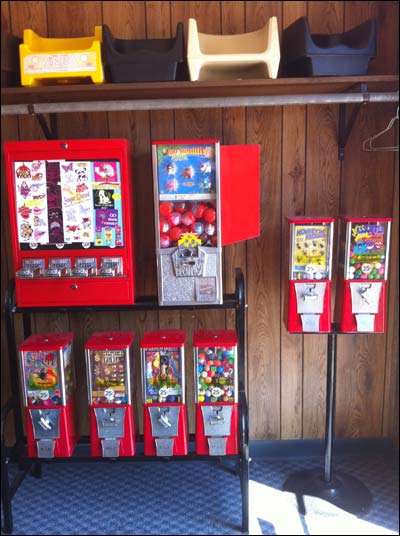
[September 2] Does anything say county-seat restaurant like paneling and a bank of quarter-eating machines that dispense candy and trinkets? I'd hate to be a parent trying to guide a child past this bank of goodies after Sunday dinner. When I was a kid, I could have spent an hour there myself just admiring the goods. This scene is at the Don Do Cafe in Larned. Ad aspera[September 2] Rick Clawson wrote in response to my question about Kansas' most famous export after basketball players and wheat. "Remember, Kansas' state motto, means 'To the Stars with Difficulties', which by the man who coined this phrase used it in reference to how much trouble Kansas went through to become a state, much of it self-inflicted..." Also, this week Rainell Goodale of Hays and Cheryl Unruh of Emporia wrote to identify a couple of people in reunion photos. Rainell pinned a name on Randy Dougherty in the 2009 class of 1973 photo, and Cheryl found Karla Mead in this year's "various classes" reunion photo. (2009 | 2010) Radium Bridge is open again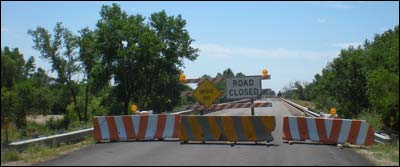
[September 1] Barton County has reopened the Radium Bridge, which crosses the Arkansas River east of Dundee and south of the Great Bend airport, according to a story in the Great Bend Tribune. It had been closed for a couple of months because some joints were unstable. During my visit last month, I slipped past the Road Closed signs by the highway and drove to the bridge. Barriers would have kept my rented car off the bridge itself even if I had tried to cross it. I walked out onto it, 20 feet above the mighty Arkansas, and felt nervously for any twinge that might foretell an catastrophic failure. It seemed safe enough, but I didn't want to tempt fate -- "Fool dies in bridge collapse," the headline would say -- and I retreated with a lively step. Folks at my school reunion the Saturday before had been describing their inconvenience suffered because the Radium and Dartmouth bridges were closed and the Great Bend U.S. 281 bridge was down to two lanes. I'm sure their stories could have been echoed by hundreds of other drivers.
What did Kansas feed these guys?[September 1] In recent days it has been publicized that Joe Miller, the Sarah Palin-supported lawyer who may deliver Alaska's junior seat in the Senate to the tea party, is from Kansas. He has already upset the apple cart. Last night Lisa Murkowski, a Republican who was handed the seat by her father on his way out of the Senate and into the governor's office, conceded the primary election. (Newspaper story) He wants the federal government to give to the state all of its Alaska land, which amounts to considerable acreage. In return, Alaska would stop taking federal money for highways, education, and so forth. Alaska could then hand over rights to its lands to the drillers, miners, lumber companies, and commercial fishing operations that now operate under federal guidance. That would make Alaska the economic engine of the United States, Mr. Miller says. I guess that would work the same way it does in Kansas, which has almost no federal land yet somehow still carries a very large budget deficit. In Alaska's case, its citizens would have to start paying state taxes. Good luck pushing for that, Mr. Miller. I imagine he would have better luck persuading the 49 other states to stop sending money to Alaska. Mr. Miller, a Fairbanks lawyer who sports the not-quite-a-beard look favored by pro quarterbacks, dictators, and other men who think they're more handsome than they are, was born in Osborne, up on the Nebraska line. His family later moved to Salina, and then he went on to West Point and Yale law school. His website doesn't mention his Kansas upbringing, but he confirmed his biography to the Salina Journal. (His own website) Mr. Miller is not the only glint-eyed Kansan to have found a political home in Alaska. • Joe Vogler, a miner, was the highly visible ramrod behind the Alaskan Independence Party. He advocated the secession of Alaska from the United States. He also lived in Fairbanks, and he kept his promise not to be buried in U.S. land. After he was shot by a burglar in 1993 he was laid to rest in Yukon Territory. He was from Barnes and earned a law degree from KU, and it appears he was encouraged to leave Kansas. (Wikipedia) • Wally Hickel was Alaska's second governor, elected as a Republican in 1966, but then he was named interior secretary by President Nixon in 1969. He lasted about a year, or the time it took to disagree with Nixon over the Vietnam War -- after he publicly told Nixon to pay more attention to the ideas of young people, he was fired. He tried again and again to become governor, but it wasn't until the Alaskan Independence Party threw out its own candidate and let him have its spot on the ballot in 1990 that he got another four years. Mr. Hickel, a construction company owner, had grand ideas about Alaskans owning their state and piping water to California, and he once told "60 Minutes" that "you can't let nature just run wild." Mr. Hickel was a boat rocker. He supported and then disavowed Sarah Palin, and he called for the resignation of Sen. Ted Stevens, who he had appointed to office in 1968. Mr. Hickel was a pleasant fellow. I talked to him a couple of times, and his brother gave me a tour of the family's farmstead. He died this year. Mr. Hickel was from Claflin. (Wikipedia) • Ralph Winterrowd was a Patriot Party candidate for governor in 1994 on a platform that was beyond Libertarian. He was defeated soundly and now has a web page and a broadcast career. Mr. Winterrowd says he was from southeast Kansas. (His web page) I look at all these former Kansans and wonder whether I should contribute more to my adoptive state and its exciting political history. I could run governor under the banner of "Elect me! I'm from Kansas!" How does Kansas -- the land of Goat Glands Brinkley, Carry Nation, John Brown, and Fred Phelps -- maintain its sanity? I can't say for sure, but sending some of its sons off to be politicians in Alaska seems to be the solution. |
Sell itAdvertise here to an audience that's already interested in Pawnee Rock: Or tell someone happy birthday. Advertise on PawneeRock.org. 
|
|
|

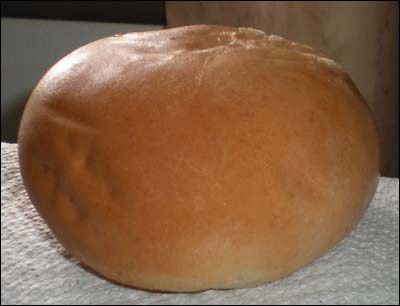
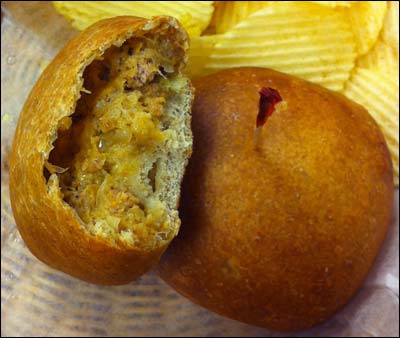

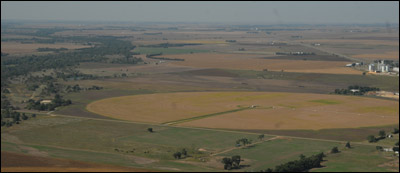
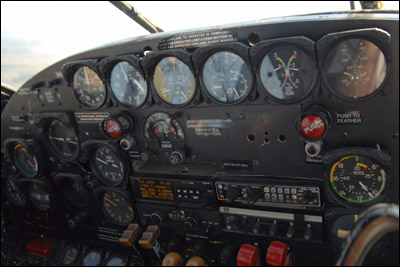
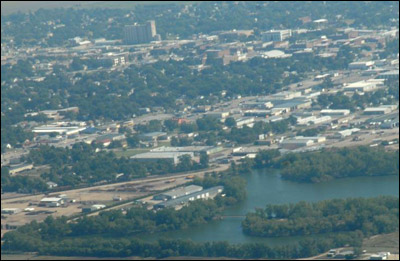

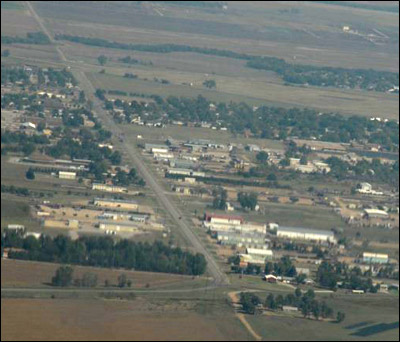
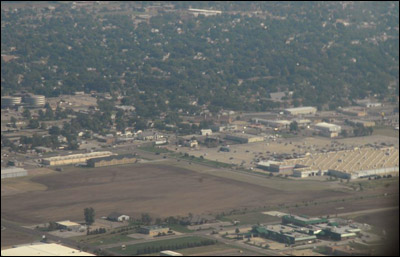
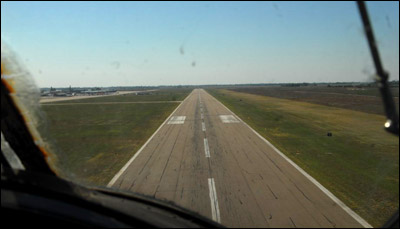
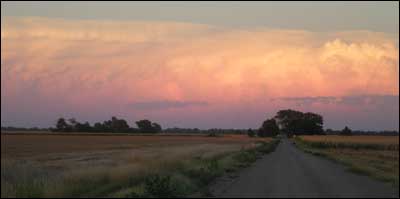
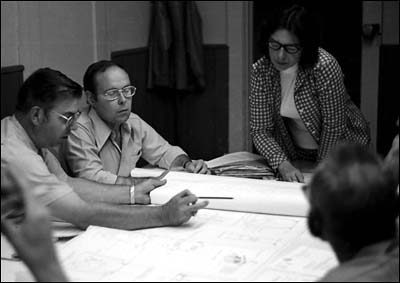
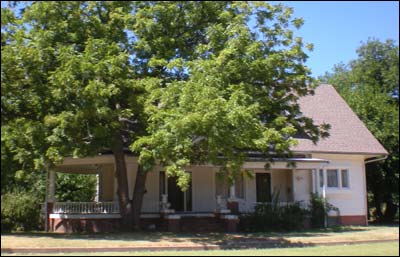
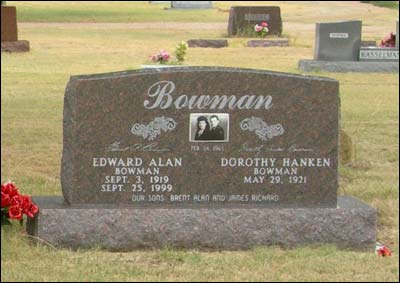
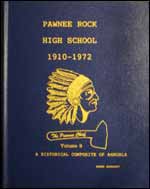 Roger's book quotes a story in the Pawnee Rock Herald:
Roger's book quotes a story in the Pawnee Rock Herald: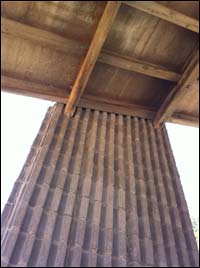 He grasped the ragged formed-concrete wall of the shelter and balanced himself as gravity pulled him to the floor. Is this what heat stroke is, he wondered. Is this . . . cicadas . . . my boys . . . there's the roof. His mind faded and the sunlight was stronger and then dimmer. He thought he might be at the end of his trail, and he knew it was because he wasn't used to the heat at all. He was a fool. He should have worn a hat.
He grasped the ragged formed-concrete wall of the shelter and balanced himself as gravity pulled him to the floor. Is this what heat stroke is, he wondered. Is this . . . cicadas . . . my boys . . . there's the roof. His mind faded and the sunlight was stronger and then dimmer. He thought he might be at the end of his trail, and he knew it was because he wasn't used to the heat at all. He was a fool. He should have worn a hat.